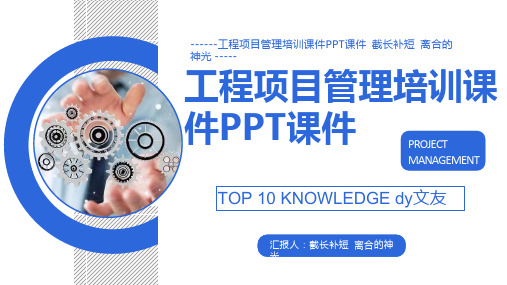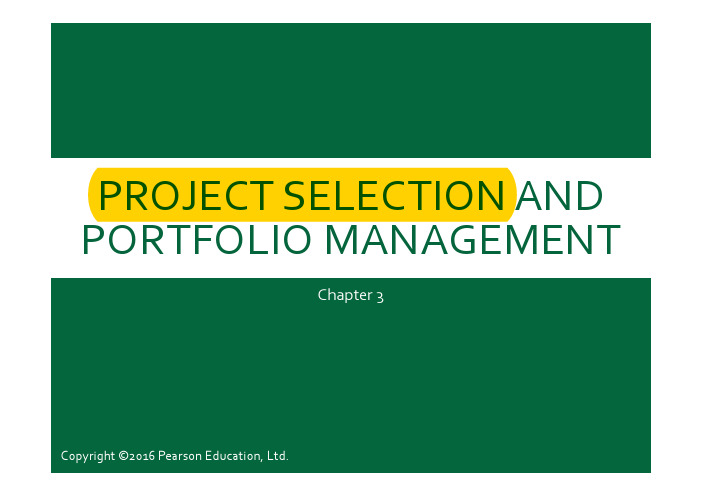项目管理培训课件3
- 格式:ppt
- 大小:500.50 KB
- 文档页数:25




PROJECT SELECTION AND PORTFOLIO MANAGEMENTChapter 3CHAPTER 3LEARNING OBJECTIVESAfter completing this chapter, students will be able to:1.Explain six criteria for a useful projectselection/screening model.2.Understand how to employ checklists and simple scoringmodels to select projects.e more sophisticated scoring models, such as theAnalytical Hierarchy Process.4.Learn how to use financial concepts, such as the efficientfrontier and risk/return models.CHAPTER 3LEARNING OBJECTIVESAfter completing this chapter, students will be able to:5.Employ financial analyses and options analysis toevaluate the potential for new project investments.6.Recognize the challenges that arise in maintaining anoptimal project portfolio for an organization.7.Understand the three keys to successful project portfoliomanagement.PMBOK CORE CONCEPTSProject Management Body of Knowledge (PMBoK) covered in this chapter includes:Portfolio Management (PMBoK1.4.2)SCREENING & SELECTION ISSUES1.Risk–unpredictability to the firma.Technicalb.Financialc.Safetyd.Qualitye.Legal exposuremercial–market potentiala.Expected return on investmentb.Payback periodc.Potential market shared.Long‐term market dominancee.Initial cash outlayf.Ability to generate future business/new marketsSCREENING & SELECTION ISSUES3.Internal operating –changes in firm operationsa.Need to develop/train employeesb.Change in workforce size or compositionc.Change in physical environmentd.Change in manufacturing or service operations4.Additionala.Patent protectionb.Impact on company’s imagec.Strategic fitAll models only partially reflect reality and have bothobjective and subjective factors imbedded.APPROACHES TO PROJECT SCREENING∙Checklist model∙Simplified scoring models∙Analytic hierarchy process∙Profile modelsCHECKLIST MODELA checklist is a list of criteria applied to possible projects.✓Requires agreement on criteria✓Assumes all criteria are equally importantChecklists are valuable for recording opinions and stimulating discussion.SIMPLIFIED SCORING MODELS Each project receives a score that is the weighted sum of its grade on a list of criteria. Scoring models require:∙agreement on criteria ∙agreement on weights for criteria ∙a score assigned for each criteriaRelative scores can be misleading!()Score Weight Score =⨯∑ANAL YTIC HIERARCHY PROCESSThe AHP is a four step process:1.Construct a hierarchy of criteria and subcriteria.2.Allocate weights to criteria.3.Assign numerical values to evaluation dimensions.4.Determine scores by summing the products ofnumeric evaluations and weights.Unlike the simple scoring model, these scores can be compared!SAMPLE AHP WITH RANKINGS FOR SALIENT SELECTION CRITERIA (FIGURE 3.1)PROFILE MODELS(FIGURE 3.4)Criteria selection as axes Rating each project on criteriaR i s kReturnMaximum Desired RiskMinimum Desired ReturnX 1X 4X 2X 3X 6X 5Efficient FrontierX 7FINANCIAL MODELS∙Payback period∙Net present value∙Discounted payback period ∙Internal rate of return∙Options models3 ‐50,000= 2.857 350,0005 –875,000= 4.028900,000(table 3.6)The project does meet our 15% requirement and should be considered further.PROJECT PORTFOLIO MANAGEMENTThe systematic process of selecting, supporting, and managing the firm’s collection of projects. Portfolio management objectives and initiatives require:∙decision making∙prioritization∙review∙realignment∙reprioritization of a firm’s projectsKEYS TO SUCCESSFULPROJECT PORTFOLIO MANAGEMENT Flexible structure and freedom of communication Low‐cost environmental scanningTime‐paced transitionPROBLEMS IN IMPLEMENTING PORTFOLIO MANAGEMENTConservative technical communitiesOut‐of‐sync projects and portfoliosUnpromising projectsScarce resourcesSUMMARY1.Explain six criteria for a useful project selection/screening model.2.Understand how to employ checklists andsimple scoring models to select projects.e more sophisticated scoring models, such asthe Analytical Hierarchy Process.4.Learn how to use financial concepts, such as theefficient frontier and risk/return models.SUMMARY5.Employ financial analyses and options analysisto evaluate the potential for new projectinvestments.6.Recognize the challenges that arise inmaintaining an optimal project portfolio for an organization.7.Understand the three keys to successful projectportfolio management.。

